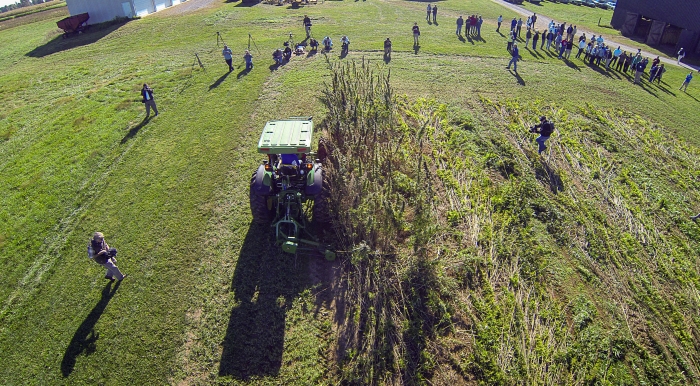 Maloney calls farm bill ‘best ever for Hudson Valley’
Maloney calls farm bill ‘best ever for Hudson Valley’
By Brian PJ Cronin
After months of deadlock revolving around such diverse issues as food stamps, wildfire management and conservation easements, the 2018 Farm Bill passed both houses of Congress and President Donald Trump signed it into law on Thursday (Dec. 20).
Sean Patrick Maloney of Cold Spring, whose district in the U.S. House includes the Highlands, and who serves on the Committee on Agriculture, called it the best farm bill ever for the Hudson Valley. (He said that about the farm bill passed in 2014, as well, but proclaimed this one even better.)
“We have won the battle, won the war, and made the progress that we wanted to help our farmers,” he said at a Dec. 14 news conference at Soons Orchards in New Hampton. “By working together with our Republican Senate colleagues, we were able to produce a farm bill that I’m very proud of.”
The Hudson Valley is home to more than 3,100 farms that cover 474,000 acres. These farms collectively produce more than $322 million of food each year. But when the farm bill was put on hold in the fall because of political disagreements, many agricultural programs were in danger of losing funding and the region’s economy placed at risk.
With the bill signed, farmers and those who work with them are breathing a sigh of relief. And its provisions ensure that if future farm bills are deadlocked, several key programs will continue to receive funding regardless.

“This bill has delivered increased and permanent funding to train the next generation of farmers, to support veteran farmers, farmers of color and indigenous farmers, for programs that support local food and expand regional markets,” said David Howard of the National Young Farmers Coalition. Drawing from Maloney’s Young and Beginning Farmers Act from 2017, the bill doubles the amount of loans that new farmers can take on and also pays for more training.
The bill preserves the current requirements that need to be met in order to receive food stamps; Republicans in the House had pushed for additional work requirements.
“A lot of people don’t know that there are already work requirements for food stamps,” said Maloney. “We’ve had them for 20 years.”
The bill also preserves the link between food stamps and heating assistance. “They wanted to break that up and make it harder for folks to get both, or have to choose between one or the other,” said Maloney. “That was nuts. We stopped it.”
When Maloney spoke to The Current in November about the pending bill, he mentioned assistance for small dairy farms as being something that he felt the previous bill was lacking. Under a program called the Dairy Margin Coverage Program, the new bill includes 100 percent price support to farms that produce under 5 million pounds of milk annually, offering financial stability for farmers.
“It’s geared toward the little guys,” said Maloney. “That’s who we have here in New York. And it’s effective retroactively, so they can get money and credits that they were not able to get under the previous farm bill.”
In addition, farmers will have new crop insurance options which will make premiums more affordable and accessible for smaller, diversified farms, he said. In the past, crop insurance programs had focused on larger farms which only grow one or two crops. Even the types of crops that farmers are able to grow will expand; the bill legalized industrial hemp cultivation and production.

“This is going to be big for New York State,” said Jen Metzger, who was elected to the state Senate in November and will chair its Agriculture Committee. “This is a crop that has an unbelievable number of diverse uses. It’s low-impact in terms of its impact on the soil, its water usage, its demand for pesticides. It grows in marginal soil. This commodity provides really significant opportunities for farmers in New York who are looking to diversify.”
Farmers markets will also see benefits. In addition to fixing a problem that prohibited certain markets from accepting electronic benefit cards for payment, the bill gives low-income consumers incentives to purchase locally grown food at the markets, where it can be more expensive than at the supermarket.
While work on the next farm bill won’t begin for several years, Maloney said he is already thinking about what could be added. In addition to a program to help young farmers with student loan debt, Maloney would like to see conservation programs expanded, especially easement programs that help new farmers by keeping the cost of land low. And with the legalization of industrial hemp production, and Gov. Andrew Cuomo voicing support for legalizing recreational marijuana, it’s not hard to tell which way the smoke will be blowing.
“We’ll be dealing with the issue very soon of recreational marijuana and expanded medical marijuana in New York,” said Maloney. “There’s real legislative priorities that have to go along with that for our local farmers. If we’re going to have it, I’d like our farmers to benefit as much as possible.”
Read more: A Growing Challenge: Farms and Food in the Hudson Valley
